Unsplash/Charlotte Venema
What is the Nature Futures Framework?
The Nature Futures Framework (NFF) is a flexible tool designed to support the development of scenarios and models of desirable futures for people, nature and Mother Earth.
Responding to identified limitations in existing scenario approaches, the NFF fills a gap by providing a heuristic tool for the development of nature-centric scenarios that address the diversity of human-nature relationships. It enables context- and place-specific policy options to be developed based on locally held values of nature in order to achieve a good quality of life (including human wellbeing and living well in balance and harmony with Mother Earth).
The NFF is intended to catalyse the development of scenarios that can be compared, and does not pre-define characteristics for individual scenarios; rather it allows the development of place- and context-specific scenarios that represent local, national, and regional priorities, ecologies and values. The use of a single framework that allows for the combining of different value perspectives for nature facilitates its application within a diverse range of regional and socio-economic contexts. It also promotes investigation of cross-scale interactions that cannot be suitably captured at single or multiple independent scales. Development of scenarios based on the NFF, within varied sociocultural, economic and political contexts and across a wide range of scales, may identify pathways toward desirable futures that achieve the goals of relevant multilateral environmental agreements and the Sustainable Development Goals.
If humanity is to achieve its goal of a more sustainable and prosperous future rooted in a flourishing nature, it is critical to open up a space for more plural perspectives of human–nature relationships. As the global community sets out to develop new goals for biodiversity, the NFF can be used as a navigation tool helping to make diverse, desirable futures possible.
Unsplash/Daniel Klein
Understanding the Nature Futures Framework triangle
As a heuristic device, the Nature Futures Framework (NFF) captures diverse, positive values for human-nature relationships in the form of a triangle. It can be used both as a boundary object to enable the opening up of more plural perspectives in the creation of desirable nature scenarios and as an actionable framework for developing nature scenarios across multiple scales. A more detailed description of the framework can be found here.
At each of its corners, the NFF considers three main ways of valuing nature - nature for nature, nature for society, and nature as culture :
In the nature for nature perspective, people view nature as having intrinsic value, and value is placed on the diversity of species, habitats, ecosystems and processes that form the natural world, and on nature’s ability to function autonomously.
The nature for society perspective highlights the utilitarian benefits and instrumental values that nature provides to people and societies.
The nature as culture/one with nature perspective primarily highlights relational values of nature, where societies, cultures, traditions and faiths are intertwined with nature in shaping diverse bio-cultural landscapes.
Unsplash/James Wheeler
Development of the Nature Futures Framework
Researchers have repeatedly called for the need to use of transformative, multi-scale global scenarios as tools as part of the quest to halt the decline of biodiversity and achieve sustainability goals. As a first step toward achieving this, researchers participating in the scenarios and models expert group of the Intergovernmental Science-Policy Platform on Biodiversity and Ecosystem Services (IPBES) initiated an iterative, participatory process that led to the development of the Nature Futures Framework (NFF).
The development of the NFF responds to conclusions of the IPBES Methodological Assessment Report on Scenarios and Models, which highlighted limitations within pre-existing scenario approaches - in particular, the degree to which approaches were able to incorporate the full range of interconnections and feedbacks between nature and people and the plurality of values and norms related to this.
The iterative process through which the NFF was developed was undertaken by the IPBES scenarios and models expert group from 2016 to 2019.
The process began with a global participatory visioning workshop in Auckland, New Zealand, in September 2017 with 73 participants from 31 countries representing all UN regions. This group included representatives from intergovernmental organisations, Indigenous peoples, national governments, NGOs, academia and the private sector with ranging expertise on biodiversity topics. The workshop’s objective was the development of positive visions of nature and their associated storylines.
Pereira et al. (2023)
Through subsequent sessions, the Auckland visions were developed by a small group of stakeholders so as to test the resonance of visions with a broader group of people, how best they can be communicated within engagement processes, and to get feedback on potential gaps and inconsistencies within the visions so these could be accounted for in the development of scenario narratives.
In June 2018, an expert meeting was held so as to develop a plan for formulating scenarios across scales based on the prior visioning process in Auckland. Responding to stakeholder engagement in the prior phase, this expert group mapped out the fundamental overlaps, similarities and differences between visions were. After many discussions, experts came to the finding that underpinning visions were the three value perspectives for how people relate to nature that subsequently now structure the NFF. The NFF triangle was then further refined alongside stakeholders before moving on to being used in developing scenario narratives.
To read about this process in full see Pereira et al. (2020).






